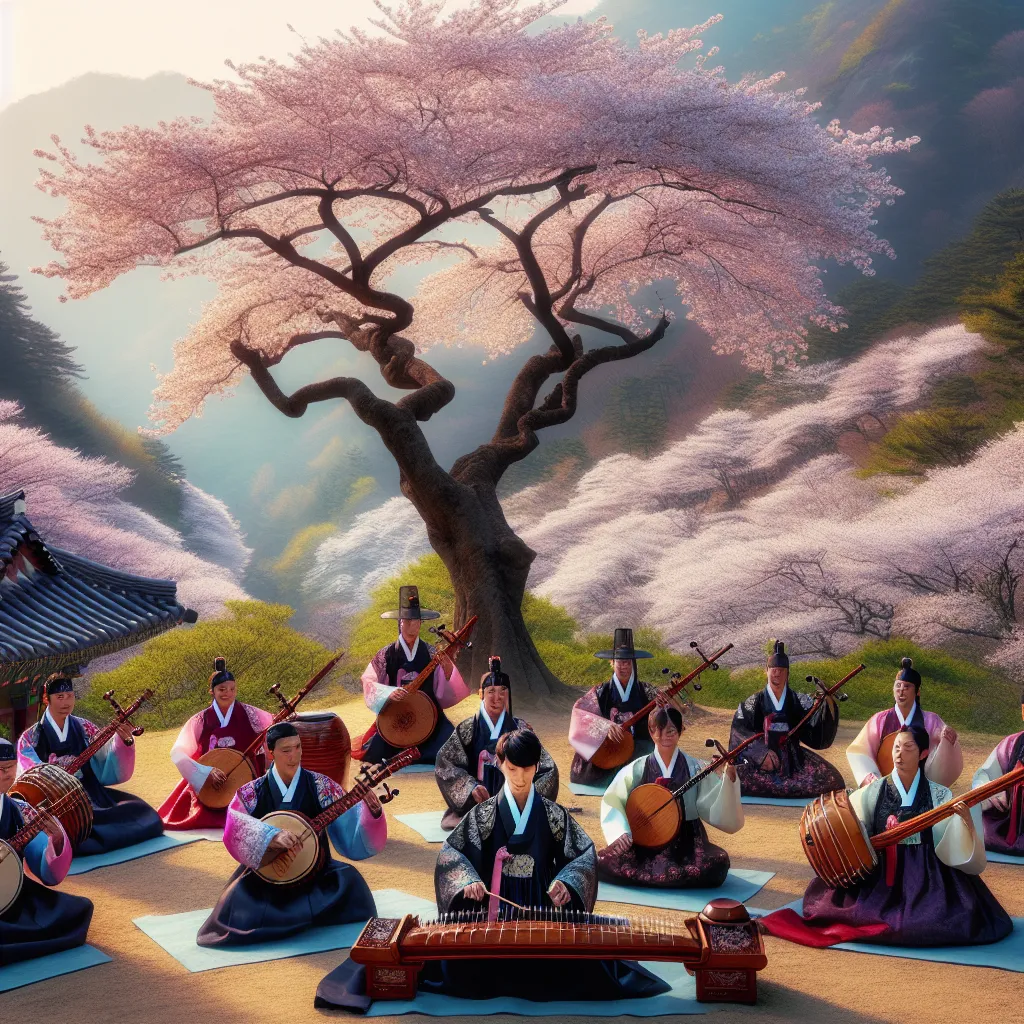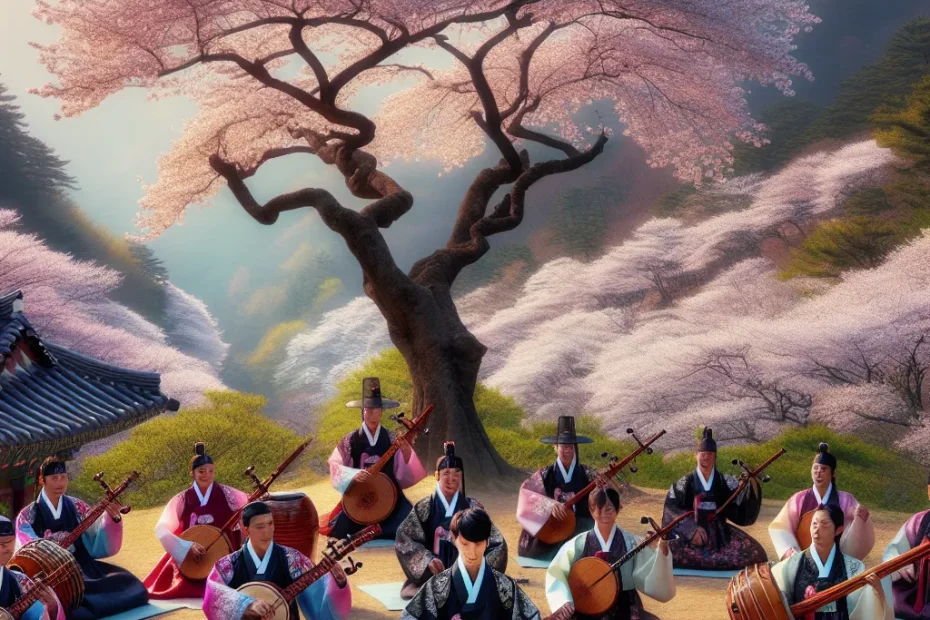Korean traditional music holds a rich heritage that reflects the country’s cultural identity and history. Originating from ancient times, this music has evolved over centuries, incorporating various influences and styles. The instruments used in Korean traditional music are unique and diverse, each contributing to the distinctive sound of the music. The characteristics of this music, such as its use of pentatonic scales and rhythmic patterns, set it apart from other musical traditions. Despite its deep roots in tradition, Korean traditional music continues to evolve, with modern influences shaping its sound and style. Exploring the sounds of Korea offers a fascinating journey into a musical world that is both timeless and ever-changing.

Origins of Korean Traditional Music
In the rich tapestry of Korean culture, traditional music holds a special place, reflecting the deep history and unique identity of the Korean people. The origins of Korean traditional music can be traced back thousands of years, with influences from various sources shaping its distinctive sound.
Ancient Beginnings
Korean traditional music, known as “gugak,” has its roots in the ancient court music of the Three Kingdoms period (57 BC – 668 AD). During this time, music played a crucial role in religious rituals, court ceremonies, and entertainment. The elegant melodies and intricate rhythms of this early music laid the foundation for the rich tradition that would follow.
Influences and Evolution
Over the centuries, Korean traditional music evolved, drawing inspiration from diverse sources such as Chinese music, Buddhist chanting, and shamanic rituals. The introduction of new instruments, scales, and musical styles enriched the repertoire, creating a vibrant tapestry of sounds that reflected the cultural exchanges of the time.
Instruments and Ensembles
Central to Korean traditional music are a variety of unique instruments, each with its own distinct timbre and role in the ensemble. From the haunting sounds of the daegeum (flute) to the rhythmic pulse of the janggu (drum), these instruments come together in ensembles like the “gagok” (vocal music) and “chamber music,” creating harmonies that resonate with the soul.
Poetry and Emotion
One of the defining features of Korean traditional music is its deep connection to poetry and emotion. Many traditional songs are inspired by ancient poems, expressing themes of love, nature, and the human experience. Through subtle nuances in melody and rhythm, Korean traditional music captures the essence of these poetic sentiments, stirring the hearts of listeners.
Preservation and Innovation
In the modern era, efforts to preserve and promote Korean traditional music have led to a resurgence of interest in this cultural heritage. Traditional music schools, festivals, and performances showcase the beauty and complexity of gugak, while contemporary artists continue to innovate and push the boundaries of this ancient art form.
As we delve into the origins of Korean traditional music, we uncover a rich tapestry of history, culture, and artistry that continues to inspire and captivate audiences around the world. Through its timeless melodies and profound emotions, gugak remains a testament to the enduring legacy of Korean musical heritage.
Instruments Used in Korean Traditional Music
Welcome to the enchanting world of Korean traditional music, where the rich sounds of centuries-old instruments resonate through time and space! In Korean traditional music, a wide array of instruments is used to create harmonious melodies that reflect the country’s cultural heritage and artistic depth. Let’s delve into the fascinating realm of these instruments and explore the unique characteristics that make them integral to the Korean musical tradition.
The Gayageum
One of the most iconic instruments in Korean traditional music is the gayageum, a zither-like instrument with 12 silk strings. The gayageum produces a delicate and ethereal sound that captivates listeners with its melodic charm. Its intricate design and the skillful technique required to play it make the gayageum a symbol of traditional Korean music.
The Daegeum
Another prominent instrument is the daegeum, a large bamboo flute with a buzzing membrane that adds a unique timbre to its sound. The daegeum is known for its dynamic range and expressive capabilities, making it a versatile instrument in traditional Korean ensembles. Its soul-stirring melodies can evoke a wide range of emotions, from joy to contemplation.
The Janggu
The janggu, a traditional drum shaped like an hourglass, provides rhythmic foundation and energy to Korean traditional music. With its two distinct heads producing contrasting tones, the janggu adds depth and complexity to musical performances. The rhythmic patterns created by skilled janggu players infuse traditional Korean music with vitality and drive.
The Geomungo
The geomungo, a large six-stringed zither, is another essential instrument in Korean traditional music. Its deep, resonant tones and intricate melodic patterns create a mesmerizing atmosphere that transports listeners to another time and place. The geomungo’s evocative sound is often featured in solo performances and ensemble settings, showcasing its versatility and expressive power.
In addition to these instruments, Korean traditional music also incorporates a variety of percussion instruments such as the buk (drum) and jing (gong), adding layers of texture and rhythm to musical compositions. The seamless blend of these instruments creates a sonic tapestry that is both culturally rich and artistically profound.
As we explore the instruments used in Korean traditional music, we gain a deeper appreciation for the craftsmanship, artistry, and cultural significance embedded in each instrument. From the gentle melodies of the gayageum to the pulsating rhythms of the janggu, Korean traditional music offers a sensory experience that is both captivating and timeless. Let the sounds of Korea’s musical heritage transport you to a world of beauty and tradition, where the echoes of the past resonate with the promise of the future. 🎶🇰🇷
Characteristics of Korean Traditional Music
Exploring the rich tapestry of Korean traditional music unveils a world of unique characteristics that set it apart from other musical traditions. Rooted in centuries-old customs and cultural practices, Korean traditional music is a vibrant reflection of the country’s history and identity. From the intricate melodies to the rhythmic patterns, each aspect of Korean traditional music showcases distinct features that captivate the senses and evoke a sense of nostalgia.
Emphasis on Improvisation and Ornamentation
One of the defining characteristics of Korean traditional music is its emphasis on improvisation and ornamentation. Musicians often add embellishments and variations to the main melody, creating a dynamic and ever-evolving performance that keeps audiences on the edge of their seats. This improvisational aspect not only highlights the skill and creativity of the musicians but also adds a sense of spontaneity and excitement to the music.
Use of Unique Scales and Modes
Another key feature of Korean traditional music is its use of unique scales and modes. The pentatonic scale, known as the “gongchepyeongjo,” is a fundamental element in many traditional Korean melodies. This scale, which consists of five notes per octave, gives Korean traditional music its distinctive sound and sets it apart from Western musical traditions. The use of these scales and modes adds a layer of complexity and richness to the music, creating a truly immersive listening experience.
Role of Rhythm
Rhythm also plays a crucial role in Korean traditional music, with intricate rhythmic patterns and drumming techniques adding depth and texture to the compositions. The use of various percussion instruments, such as the janggu and buk, creates a pulsating beat that drives the music forward and sets the pace for the performers. These rhythmic elements not only provide a strong foundation for the music but also showcase the precision and coordination of the musicians.
Integration with Dance and Theater
Beyond the musical aspects, Korean traditional music is deeply intertwined with other art forms, such as dance and theater. Many traditional Korean musical performances are accompanied by elaborate dance routines that enhance the storytelling and emotional impact of the music. The seamless integration of music, dance, and theater creates a multi-sensory experience that transports audiences to a different time and place, immersing them in the beauty and complexity of Korean culture.
In conclusion, the characteristics of Korean traditional music are as diverse and captivating as the culture from which they stem. From the improvisational flair of the musicians to the intricate scales and rhythmic patterns, Korean traditional music offers a window into a world of artistry and tradition that continues to inspire and enchant audiences around the globe.
Modern Influence on Korean Traditional Music
In recent years, the landscape of Korean traditional music has been significantly shaped by modern influences, reflecting a dynamic fusion of the old and the new. This blending of traditional Korean musical elements with contemporary styles has not only revitalized the genre but also introduced it to a wider, global audience 🎶🌏.
Incorporation of Electronic Instruments
One notable modern influence on Korean traditional music is the incorporation of electronic instruments and digital production techniques. By infusing traditional melodies with electronic beats and synthesizers, musicians have been able to create a fresh sound that appeals to younger generations while still honoring the rich cultural heritage of Korea 🎵🔊.
Impact of K-pop
Furthermore, the rise of K-pop and its global popularity has had a profound impact on Korean traditional music. Many K-pop artists have incorporated traditional Korean instruments such as the gayageum and the janggu into their music, giving a modern twist to age-old sounds 🎤🎸. This cross-pollination of genres has not only brought traditional Korean music to a new audience but has also sparked a renewed interest in preserving and promoting this important cultural heritage 🌟🎶.
Collaborations with Diverse Musical Backgrounds
In addition, collaborations between traditional Korean musicians and artists from diverse musical backgrounds have led to innovative and exciting projects. These collaborations have resulted in unique performances that blend traditional Korean sounds with jazz, hip-hop, and even classical music, pushing the boundaries of what is possible in the realm of traditional music 🎷🎹.
Accessibility through Online Platforms
The modern influence on Korean traditional music is not just limited to the sounds themselves but also extends to the way in which the music is presented and consumed. With the advent of online streaming platforms and social media, traditional Korean music is now more accessible than ever before, reaching audiences around the world in a matter of seconds 🌐📱.
Overall, the modern influence on Korean traditional music has brought about a renaissance in the genre, breathing new life into age-old traditions and ensuring that the heritage of Korean music continues to thrive in the digital age. As we look to the future, it is clear that the fusion of traditional and modern influences will continue to shape and evolve Korean traditional music, creating a dynamic and vibrant musical landscape for generations to come 🎶🌟.
In conclusion, the heritage of Korean traditional music is a rich tapestry of sounds that reflect the history, culture, and spirit of Korea. From its ancient origins to its modern influences, Korean traditional music continues to captivate audiences around the world with its unique instruments, melodies, and rhythms. As we explore the characteristics and instruments used in Korean traditional music, we gain a deeper appreciation for the artistry and craftsmanship that have been passed down through generations. The modern influences on Korean traditional music serve to both preserve its legacy and propel it into the future, ensuring that this vibrant musical tradition will continue to thrive for years to come.
